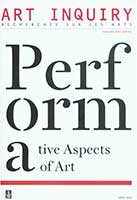Visual Event as the effect of a network. Performative aspects of Internet-Mediated Communication in Net Art
Visual Event as the effect of a network. Performative aspects of Internet-Mediated Communication in Net Art
Author(s): Konrad ChmieleckiSubject(s): Fine Arts / Performing Arts
Published by: Łódzkie Towarzystwo Naukowe
Keywords: performativity; visual event; Internet-mediated communication; net art; communitas
Summary/Abstract: The starting point of the article is the assumption that the performative turn directs our attention to the expressive dimension of social activity and to events which have the character of a process. If we transfer this assumption to the field of visual culture, then the object of our inquiry will no longer be images, but rather their perception by the participants of visual events or the processes leading to those events. The performative aspects may be noticed in the definition of the “visual event” formulated by Nicholas Mirzoeff, who suggests the introduction of this term to replace “image”. In accordance with this concept, the visual event constitutes the main aspect of reception – the process of seeing in which the user or the consumer seeks information, meaning or pleasure in an encounter with visual technology: from an oil painting to television and the Internet. The main thesis of the article is that the visual event is the product of a network, which in turn conditions the actions of the users communicating with one another. The performative aspects of Internet-mediated communication are revealed when Internet users employ speech acts. Simultaneously with this process of “doing things with words”, the interlocutors communicating with one another create a “community” which resembles communitas (the term used by Victor Turner). We can view the communitas as a network community in which the Internet users interact with one another not only with the help of verbal messages, but also with other forms of online communication (images derived from web-cameras, flash animations, photoblogs). The presented issues find their reflection in the artwork Listening Post (2003) by Mark Hansen and Ben Rubin, the “visualisation” of Internet-mediated communication of the users employing speech acts in chat rooms. The online verbal communication used in this work takes on the dimensions of a performance which is the source of its visual aspect, and the speech acts employed by the Internet users function as the “citations” within the “iterability model” in the sense suggested by Jacques Derrida. The artwork Bodies©INCorporated (1993) by Victoria Vesna is another example of the performative aspects of Internet-mediated communication, which is described in the context of Judith Butler’s theory of perfomativity. These examples present the ways of using performative aspects of Internet-mediated communication in net art.
Journal: Art Inquiry
- Issue Year: 2012
- Issue No: 14
- Page Range: 199-219
- Page Count: 21
- Language: English

